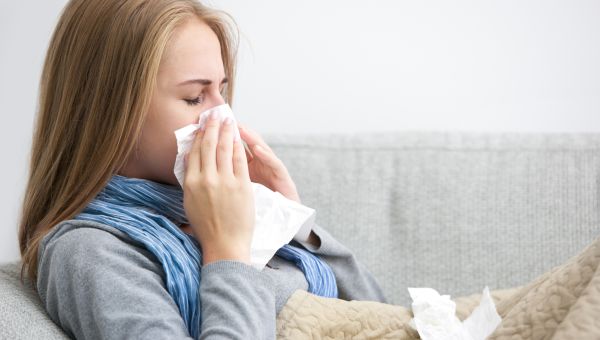How to survive cold and flu season this year
From opening a window for a little fresh air to disinfecting your kids’ toys, these easy tips can keep you healthy during cold and flu season.

‘Tis the season for aches, pains, sneezes and snot. Yuck! With germs lurking around every corner, it may seem like getting sick is inevitable—but it’s not. Protect yourself against cold and flu viruses with these germ-busting tips from Alvin Haynes, MD, of the Regional Medical Center of San Jose in California.

Open a Window
The chilly winter air makes us want to crank up the heat, snuggle on the couch and hibernate. But, all those hours spent indoors actually increase your chances of coming into contact with germs and getting sick. “When people cough or sneeze, the virus particles are suspended in the air for a little… Show More
The chilly winter air makes us want to crank up the heat, snuggle on the couch and hibernate. But, all those hours spent indoors actually increase your chances of coming into contact with germs and getting sick. “When people cough or sneeze, the virus particles are suspended in the air for a little bit of time, allowing others to breathe them in and become ill,” explains Dr. Haynes.
An easy fix: Open a window. It’ll allow for better airflow in the house, and will move that stagnant, virus-infected air outside.
Show Less
Get Vaccinated
The CDC advises most everyone 6 months and older get the flu vaccine each year. The vaccine is the best way to protect against the flu virus during flu season, which typically occurs between October and May. It’s even more important for those with a history of chronic kidney disease, asthma, COPD… Show More
The CDC advises most everyone 6 months and older get the flu vaccine each year. The vaccine is the best way to protect against the flu virus during flu season, which typically occurs between October and May. It’s even more important for those with a history of chronic kidney disease, asthma, COPD or pneumonia, says Haynes.
Show Less
Stop Fidgeting
Little idiosyncrasies like biting your fingernails or running your fingers through your hair are easy avenues for viruses to spread, says Haynes. So, how can you stop doing something you don’t even think about?
Try this: If you’re sitting at a desk all day, tape a note to your computer screen… Show More
Little idiosyncrasies like biting your fingernails or running your fingers through your hair are easy avenues for viruses to spread, says Haynes. So, how can you stop doing something you don’t even think about?
Try this: If you’re sitting at a desk all day, tape a note to your computer screen reminding yourself to keep your hands off your face. Also, always keep antibacterial gel within arms reach and use it often.
Show Less
Practice Good Hygiene
Washing your hands frequently—and properly—is one of the easiest ways you can fend off a cold and the flu. Next time you’re at the sink, spend at least 20 seconds washing your hands; sing “Happy Birthday” in its entirety twice before rinsing. Remember to use warm water and wash the top of your… Show More
Washing your hands frequently—and properly—is one of the easiest ways you can fend off a cold and the flu. Next time you’re at the sink, spend at least 20 seconds washing your hands; sing “Happy Birthday” in its entirety twice before rinsing. Remember to use warm water and wash the top of your hands and in between your fingers to clean all the nooks and crannies where the viruses may be hiding, Haynes says.
After you’ve given your hands a good scrub, dry them with a clean paper towel. “The mechanical force of rubbing paper towels over your hands collects the virus after washing your hands,” Haynes explains.
Show Less
Keep Your House Clean
Sure, you routinely vacuum the carpet and wipe the kitchen and coffee tables, but you may be missing some germ hotspots. Refrigerator handles, remote controls and kids’ toys are all havens for germs, says Haynes. Eliminate germs from your house by disinfecting these items and washing your kids’… Show More
Sure, you routinely vacuum the carpet and wipe the kitchen and coffee tables, but you may be missing some germ hotspots. Refrigerator handles, remote controls and kids’ toys are all havens for germs, says Haynes. Eliminate germs from your house by disinfecting these items and washing your kids’ toys on a regular basis, particularly during cold and flu season.
Show Less
What to Do If You Get Sick
If you do get sick, Haynes suggests the following:
- Call in sick: Whenever you have a fever, stay home. If your fever is over 100 degrees Fahrenheit and/or your symptoms are not getting better or worsening, call your doctor. It’s usually safe to return to work or school when you’ve been fever- … Show More
If you do get sick, Haynes suggests the following:
- Call in sick: Whenever you have a fever, stay home. If your fever is over 100 degrees Fahrenheit and/or your symptoms are not getting better or worsening, call your doctor. It’s usually safe to return to work or school when you’ve been fever-free for at least 24 hours.
- Listen to mom: Treat yourself the same way your mother treated you when you got sick as a child: rest on the couch, eat chicken soup, drink lots of fluids and take a pain reliever for aches and pains.
- Cover your mouth: The last thing you want is to spread your germs to your loved ones or colleagues, so “keep those viruses off your hands by sneezing into your shirt or the crook of your arm,” says Haynes.
- Try some common cold remedies: While these won’t actually get rid of the common cold, they can help ease your symptoms. Vitamin C, humidifiers and gargling with saltwater are just a few ideas.
More On


video

article


video


video


video
